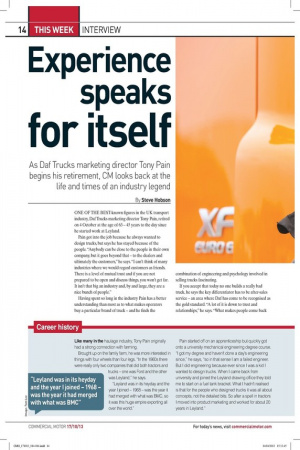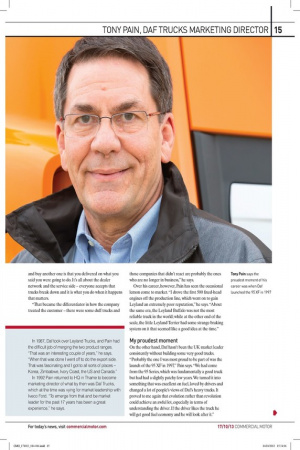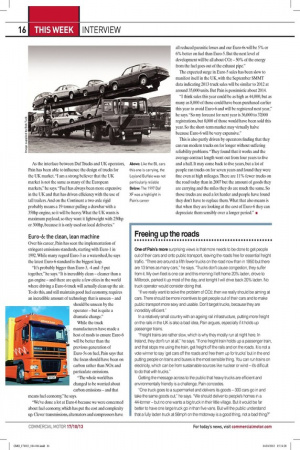Experience speaks for itself'
Page 10

Page 11

Page 12

If you've noticed an error in this article please click here to report it so we can fix it.
As Daf Trucks marketing director Tony Pain begins his retirement, CM looks back at the Life and times of an industry legend By Steve Hobson
ONE OF THE BEST-known figures in the UK transport industry, Daf Trucks marketing director Tony Pain, retired on 4 October at the age of 63 — 45 years to the day since he started work at Leyland.
Pain got into the job because he always wanted to design trucks, but says he has stayed because of the people. "Anybody can be close to the people in their own company, but it goes beyond that — to the dealers and ultimately the customers," he says. "I can't think of many industries where we would regard customers as friends. There is a level of mutual trust and if you are not prepared to be open and discuss things, you won't get far. It isn't that big an industry and, by and large, they are a nice bunch of people." Having spent so long in the industry Pain has a better understanding than most as to what makes operators buy a particular brand of truck — and he finds the
combination of engineering and psychology involved in selling trucks fascinating. If you accept that today no one builds a really bad truck, he says the key differentiator has to be after-sales service — an area where Daf has come to be recognised as the gold standard. "A lot of it is down to trust and relationships," he says. "What makes people come back
and buy another one is that you delivered on what you said you were going to do. It's all about the dealer network and the service side — everyone accepts that trucks break down and it is what you do when it happens that matters. "That became the differentiator in how the company treated the customer — there were some duff trucks and
those companies that didn't react are probably the ones who are no longer in business," he says.
Over his career, however, Pain has seen the occasional lemon come to market. "I drove the first 500 fixed-head engines off the production line, which went on to gain Leyland an extremely poor reputation," he says. "About the same era, the Leyland Buffalo was not the most reliable truck in the world; while at the other end of the scale, the little Leyland Terrier had some strange braking system on it that seemed like a good idea at the time."
My proudest moment
On the other hand, Daf hasn't been the UK market leader consistently without building some very good trucks. "Probably the one I was most proud to be part of was the launch of the 95 XF in 1997 Pain says. "We had come from the 95 Series, which was fundamentally a good truck but had had a slightly patchy few years. We turned it into something that was excellent on fuel, loved by drivers and changed a lot of people's views of Daf's heavy trucks. It proved to me again that evolution rather than revolution could achieve an awful lot, especially in terms of understanding the driver. If the driver likes the truck he will get good fuel economy and he will look after it."
As the interface between Daf Trucks and UK operators, Pain has been able to influence the design of trucks for the UK market. "I am a strong believer that the UK market is not the same as many of the European markets," he says. "Fuel has always been more expensive in the UK and that has driven efficiency with the use of tall trailers. And on the Continent a two-axle rigid probably means a 19-tonner pulling a drawbar with a 350hp engine, so it will be heavy. What the UK wants is maximum payload, so they want it lightweight with 250hp or 300hp, because it is only used on local deliveries."
Euro-6: the clean, lean machine
Over his career, Pain has seen the implementation of stringent emissions standards, starting with Euro-1 in 1992. While many regard Euro-3 as a watershed, he says the latest Euro-6 standard is the biggest leap. "It's probably bigger than Euro-3, -4 and -5 put together," he says. "It is incredibly clean — cleaner than a gas engine — and there are quite a few cities in the world where driving a Euro-6 truck will actually clean up the air. To do this, and still maintain good fuel economy, requires an incredible amount of technology that is unseen — and
should be unseen by the operator — but is quite a dramatic change." While the truck
manufacturers have made a host of mods to ensure Euro-6 will be better than the previous generation of Euro-5s on fuel, Pain says that the focus should have been on carbon rather than NOx and particulate emissions. "The whole world has changed to be worried about carbon emissions — and that
means fuel economy," he says. "We've done a lot at Euro-6 because we were concerned about fuel economy, which has put the cost and complexity up. Clever transmissions, alternators and compressors have
all reduced parasitic losses and our Euro-6s will be 5% or 6% better on fuel than Euro-5. But the next level of development will be all about CO2 — 50% of the energy from the fuel goes out of the exhaust pipe."
The expected surge in Euro-5 sales has been slow to manifest itself in the UK, with the September SMMT data indicating 2013 truck sales will be similar to 2012 at around 35,000 units. But Pain is pessimistic about 2014.
"I think sales this year could be as high as 44,000, but as many as 8,000 of those could have been purchased earlier this year to avoid Euro-6 and will be registered next year," he says. "So my forecast for next year is 36,000 to 37,000 registrations, but 8,000 of those would have been sold this year. So the short-term market may virtually halve because Euro-6 will be very expensive." This is also partly driven by operators finding that they can run modern trucks on for longer without suffering reliability problems. "They found that it works and the average contract length went out from four years to five and a half. It may come back to five years, but a lot of people ran trucks on for seven years and found they were fine even at high mileages. There are 11% fewer trucks on the road today than in 2007 but the amount of goods they are carrying and the miles they do are much the same. So those trucks are used a lot harder and people have found they don't have to replace them. What that also means is that when they are looking at the cost of Euro-6 they can depreciate them sensibly over a longer period." •








































